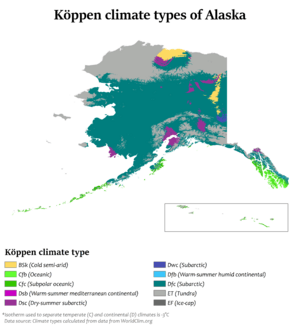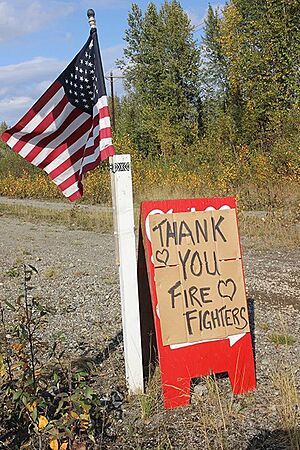Climate change in Alaska facts for kids
Climate change means big shifts in Earth's weather patterns over a long time. In Alaska, these changes are happening fast and affecting everything from the land to the animals. Winters are getting warmer, which changes how snow falls and melts. This can harm trees like the yellow cedar because their roots get too cold without enough snow to protect them.
Melting glaciers are also a big problem. They cause more water to flow into rivers and wetlands, changing where animals live. Some animals, like black-tailed deer and moose, might find it easier to move around with less snow. But others, like the northwestern deer mouse that lives under the snow, could struggle.
To help with these issues, the Alaska Climate Change Sub-Cabinet was created in 2006. Their job was to advise the Governor on how to deal with climate change. This included looking at ways to reduce greenhouse gas emissions by using cleaner energy and planning transportation better.
Contents
What Changes Have Been Seen?
Alaska has been getting much warmer. Over the last 60 years, most of the state has warmed by about 3 degrees Fahrenheit on average. Winters have warmed even more, by about 6 degrees. This warming has led to several big changes:
- Arctic sea ice is shrinking.
- Coastlines are eroding, meaning the land is washing away.
- Glaciers are getting smaller.
- Permafrost (ground that stays frozen all year) is thawing.
- There are more insect outbreaks and wildfires.
These changes can damage buildings and roads built on permafrost. They also threaten Alaska's important fishing industry.
Alaska's Rainforests and Warming
Southeast Alaska has a special kind of forest called a temperate rainforest. It's always wet and gets a lot of rain, even in summer. This forest is usually cool, and it has snow in winter. It's full of tall trees like Sitka spruce and western hemlock.
Normally, these rainforests are safe from fires because they are so moist. Wind is the main thing that disturbs them, blowing down trees. However, with warmer temperatures, the growing season for trees is longer. This also means that fungi, which can cause trees to rot, might grow more. This could make the old, big trees more likely to fall over.
Coastlines Washing Away
Many towns in Alaska are at risk from coastal erosion and rising sea levels. A report from 2009 said that 21 communities were in direct danger. For example, the village of Kivalina, Alaska was expected to be covered by water by 2025. This means people might need to move their homes to safer places.
Protecting the Trans-Alaska Pipeline
The Trans-Alaska Pipeline System carries oil across the state. In recent years, heavy rains from climate change have caused rivers to flood dangerously close to the pipeline. For example, in May 2019, the Dietrich River flooded and washed away a lot of land near the pipeline. A few months later, the Sagavanirktok River also flooded, leaving very little space between the river and the pipeline.
Workers have had to do emergency repairs to protect the pipeline. They are also trying new things like installing ground chillers to keep the soil frozen under parts of the pipeline.
What Changes Are Expected?
Scientists use special computer models to predict how climate change will affect Alaska in the future. These models look at how much carbon dioxide (a greenhouse gas) is released into the air. They predict that even with efforts to use cleaner energy, Alaska will continue to get warmer.
Warmer Temperatures and More Rain
The southeast region of Alaska is expected to get much warmer over the next century. This means the growing season for plants will be longer. While there might be more rain, the warmer temperatures could also cause more water to evaporate from plants and the ground. This could lead to wetlands drying out and glaciers melting even faster.
Scientists predict that by 2040, the average yearly temperature in southeast Alaska could increase by about 3 degrees Fahrenheit. By 2080, it could be 6 degrees Fahrenheit warmer than it is now. Winter temperatures are expected to rise even more dramatically. This means less snow and more rain, which changes the environment for plants and animals.
How Wildlife Will Be Affected
Changes in snow cover and longer growing seasons will impact animals. Animals like blacktailed deer, moose, and mountain goat might find it easier to find food in winter with less deep snow. This could mean more of them survive the winter.
However, the northwestern deer mouse relies on snow for protection. Less snow could make it harder for them to survive. The yellow-cedar tree, which is important in the rainforest, is also at risk. Its roots are sensitive to cold, and snow usually protects them. With less snow and earlier thaws, these trees can die.
Alaska's Climate Change Plans
Alaska has been working on plans to address climate change. In 2005, Alaska used a lot of energy, especially natural gas, for its industries. The state's main industry is food manufacturing.
Energy and Policy Efforts
In the past, Governor Frank Murkowski created the Rural Energy Action Council. This group was tasked with finding ways to make energy cheaper and more reliable for Alaskans, especially those in rural areas not connected to the main power grid. They looked into things like using wind turbines and saving energy.
In 2018, a group called the Climate Action Leadership Team drafted new plans for the state. These plans aimed to reduce greenhouse gas emissions and use more renewable energy. However, Governor Mike Dunleavy later ended this team.
Cleaner Fuels and Power
Alaska has also looked into using cleaner fuels. For example, there's a tax break for fuel that contains at least 10% ethanol, which helps reduce pollution. The state's Department of Transportation also tries to use alternative fuels for vehicles when possible.
Alaska is also exploring solar power and wind power as ways to generate electricity more cleanly.
Oil and Gas Decisions
Recently, there have been important court decisions about oil and gas projects in Alaska. In December 2020, a federal court stopped a large offshore oil project. The court said that the project's impact on emissions and wildlife, like polar bears, had not been properly reviewed. Environmental groups saw this as a win for protecting the climate and polar bears.
In August 2021, another federal court blocked a planned oil and gas project on Alaska's North Slope. The judge ruled that the project's approval didn't properly consider how it would affect polar bears or the amount of greenhouse gases it would release. These decisions show a growing focus on protecting Alaska's environment from the effects of climate change.
See also
- List of U.S. states and territories by carbon dioxide emissions
- Plug-in electric vehicles in Alaska




